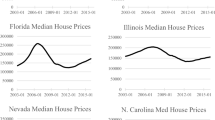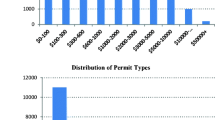Abstract
We investigate the returns to individuals who invested in residential real estate over 1999–2015. Using purchase and sales prices, we measure returns on properties that were both bought and sold by an investor using annualized price appreciation. We find that investors outperform market indices. Real estate investors earn larger returns if they live near the investment property, buy without a mortgage, and have experience in real estate investing. These characteristics are associated with investors paying less, as a percentage of the assessed value, for the property. Investors earn smaller returns on houses that they live in than on other property. Since appreciation reflects expenditures on improvements, we study land and mobile home investments where returns are less likely to be affected by improvements and document similar results. Overall, we highlight the risk and returns of residential real estate investments by retail investors. In addition, this paper sheds light on the role of investors in the residential market.



Similar content being viewed by others
Notes
See Real Estate Investment Realities (2012) for further details.
See Gao and Li (2012).
See Fortune (2017) for further details.
The annualized price appreciation for each property proxies for the return.
Zillow generates their data from county records. They appear to have started by compiling data for large counties with active real estate markets. Over time, they have expanded the number of counties. Rather than all 50 states we consider a subset of 14 states. If we included data for all states, we would have very little or no data in the early years for states like North Dakota, Vermont, Kansas, etc. Secondly, many states have non-disclosure laws where the sale price is not revealed and hence a comprehensive transaction dataset is not available for such states. Lastly, the descriptions of properties are idiosyncratic, contain misspellings, and abbreviations. These descriptions also differ significantly from state to state. For example, “double bungalow” is a term we encounter in descriptions of Minnesota property but not elsewhere. We use descriptions of the properties from deed records of the states in our sample to determine whether they are houses, recreational properties, condos, apartments, mobile homes or land.
In addition, we have information on investor transactions in land and mobile homes. While our focus in the paper is on houses, condominiums, and apartments, we do examine returns on these other properties.
See Swanson (2016) for further details.
Results are very similar when we use $1000 as a minimum purchase and sales price.
References
Allen, M. T., Rutherford, J., Rutherford, R., & Yavas, A. (2018). Impact of Investors in Distressed Housing Markets. The Journal of Real Estate Finance and Economics, 4, 622–652.
Bailey, M., Muth, R., & Nourse, H. (1963). A regression method for real estate price index construction. Journal of the American Statistical Association, 58, 933–942.
Bayer, P., Geissler, C., Mangum, K., & Roberts, J. (2011). Speculators and middleman: The strategy and performance of investors in the housing market (p. 16784). NBER Working Paper.
Bayer, Patrick, Kyle Mangum, and James Roberts (2016). Speculative fever: Investor contagion in the housing bubble, working paper, Duke University.
Case, Karl E., and Robert J. Shiller (1987). Prices of single family homes since 1970: New indexes for four cities. No. w2393. National Bureau of Economic Research.
Chetty, R., Sándor, L., & Szeidl, A. (2017). The effect of housing on portfolio choice. The Journal of Finance, 72(3), 1171–1212.
Chinco, A., & Mayer, C. (2016). Misinformed speculators and mispricing in the housing market. Review of Financial Studies, 29(2), 486–522.
Cocco, J. F. (2005). Portfolio choice in the presence of housing. The Review of Financial Studies, 18(2), 535–567.
DeFusco, A., Ding, W., Ferreira, F., & Gyourko, J. (2017). The role of price spillovers in the American housing boom, working paper. Northwestern University.
Flavin, M., & Yamashita, T. (2002). Owner-occupied housing and the composition of the household portfolio. American Economic Review, 92(1), 345–362.
Fortune (2017). Article available at http://fortune.com/2017/12/28/house-value-gain-zillow/
Gao, Z., & Li, W. (2012). Real estate investors and the boom and bust of the US housing market, working paper. Federal Reserve Bank of Philadelphia.
Genesove, D., & Mayer, C. (2001). Loss aversion and seller behavior: Evidence from the housing market. The Quarterly Journal of Economics, 116(4), 1233–1260.
Giacoletti, M., & Westrupp, V. (2017). Residential real estate traders: Returns, risk and strategies, working paper. Stanford Graduate School of Business.
Kurlat, P., & Stroebel, J. (2015). Testing for information asymmetries in real estate markets. The Review of Financial Studies, 28(8), 2429–2461.
Li, Wenli (2015). Smart money or dumb money: Investors’ role in the housing bubble. Federal Reserve Bank of Philadelphia Business Review.
Mills, J., Molloy, R., & Zarutskie, R. (2017). Large-scale buy-to-rent Investors in the Single-Family Housing Market: The emergence of a new asset class. Real Estate Economics, 47(2), 399–430.
Peng, L., & Zhang, L (2019). House prices and systematic risk: Evidence from microdata. Real Estate Economics.
Real Estate Investment Realities (2012). Joint Biggerpockets.com/Memphis Invest National Survey of Residential Real Estate Investors.
Swanson, Jann (2016). 1 in 3 homes still bought with cash, Mortgage News Daily, February 4, 2016.
Acknowledgement
We thank an anonymous referee for insightful comments. Data provided by Zillow through the Zillow Transaction and Assessment Dataset (ZTRAX). More information on accessing the data can be found at http://www.zillow.com/ztrax. The results and opinions are those of the authors and do not reflect the position of Zillow Group.
Author information
Authors and Affiliations
Corresponding author
Ethics declarations
Conflict of Interest
The authors declare that they have no conflict of interest.
Additional information
Publisher’s Note
Springer Nature remains neutral with regard to jurisdictional claims in published maps and institutional affiliations.
Rights and permissions
About this article
Cite this article
D’Lima, W., Schultz, P. Residential Real Estate Investments and Investor Characteristics. J Real Estate Finan Econ 63, 354–393 (2021). https://doi.org/10.1007/s11146-020-09771-8
Published:
Issue Date:
DOI: https://doi.org/10.1007/s11146-020-09771-8




